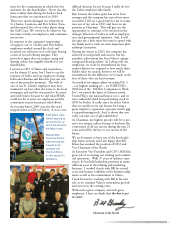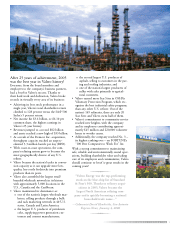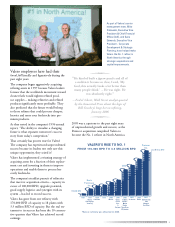Valero 2005 Annual Report Download - page 17
Download and view the complete annual report
Please find page 17 of the 2005 Valero annual report below. You can navigate through the pages in the report by either clicking on the pages listed below, or by using the keyword search tool below to find specific information within the annual report.
VA L E R O E N E R G Y C O R P O R AT I O N 15
Never afraid to take a calculated risk,
Valero executives made a fortuitous bet when
the company entered the refining business
more than 20 years ago.
They predicted that as global oil consump-
tion rose, it would be met with more plentiful
heavy, sour feedstocks. Seeing an opportunity
to gain a competitive advantage, Valero config-
ured its refining system to process these harder-
to-refine feedstocks that sell at a discount to
sweet crude oil.
Over the years, this bet has paid off hand-
somely!
As oil demand has continued to grow, the
incremental demand has been increasingly
met by medium and heavier sour crude oils.
Because of the limited refining capacity capable
of upgrading these crudes, demand hasn’t been
as strong for sour crude oils and as a result,
supplies have been increasingly more plentiful,
resulting in big discounts for complex refiners
like Valero.
At the same time, demand for sweet crude oils
– fueled by the ongoing domestic and global
movement toward cleaner fuels – has been on
the rise. To meet the new low-sulfur specifica-
tions for fuel, many refiners are relying on
sweet crudes, which has further widened the
sweet/sour price differential.
And, of course, these bullish fundamentals
have played right into Valero’s hands!
“With a focus on the harder-to-refine sour
types of crude oil, Valero’s profits are being
boosted by a glut in supplies of sour crude,
which means its feedstock is relatively
cheap…If I had to pick one (to invest in out
of all refiners), given its scale, ambition, and
lower valuation, it would be Valero.”
-- BusinessWeek, October 24, 2005
RESID
MAYA
ARAB LIGHT/MEDIUM
$2
$4
$6
$8
$10
$12
$14
$16
$18
$20
2002 2003 2004 2005
RECORD DISCOUNTS
RESIDUAL FUEL AND SOUR CRUDE OIL DISCOUNTS
TO WEST TEXAS INTERMEDIATE CRUDE
Wade Upton, Senior Vice
President – Transportation
Services [left], and Bob
Beadle, Senior Vice President
– Crude & Feedstock Supply
& Trading [center], work
together to secure and
ship the most economical
crude oils and feedstocks
to Valero’s 18 refineries.
Processing deeply discounted
feedstocks was a big advan-
tage in 2005 as discounts
reached record levels.
The discounts for the heavier, sour feedstocks
– which make up over 60 percent of Valero’s
feedstock slate – widened to record levels in
2005 and early 2006.
Recent acquisitions and internal projects have
given Valero even more leverage to these dis-
counts. For example, the company estimates
that it will process an additional 250,000 BPD
of medium and heavy crude in 2006 as a result
of its acquisition of the Port Arthur refinery
alone.
Internal projects like the 2003 construction of
the 45,000-BPD coker at the Valero Texas City
Refinery have strengthened this advantage. The
coker’s original economics were based upon
an historic $6-7 Maya discount (compared to
the benchmark West Texas Intermediate), but
in 2005 that discount actually averaged nearly
$16!
Valero’s bet should continue to pay off as dis-
counts for heavy, sour feedstocks are expected
to stay wide. Because Valero has the most con-
version capacity of any U.S. refiner, this advan-
tage should continue to give the company a
real hand up on the competition!
























